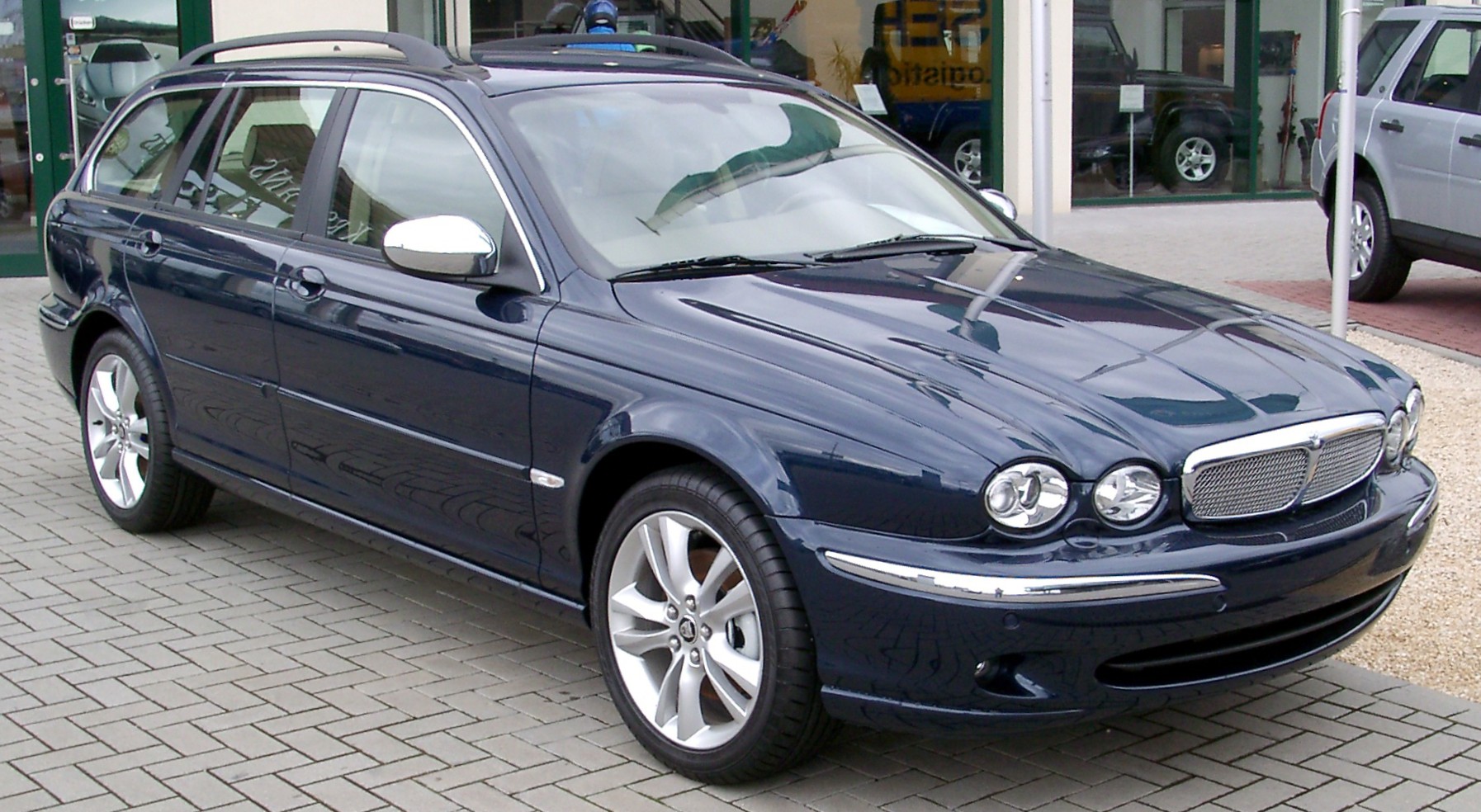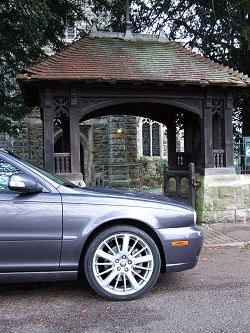The X-Type, codenamed X400, was Jaguar's first compact 4-door saloon since the Jaguar Mark 1 of 1955. The X-Type was one of the last to be styled under the supervision of Geoff Lawson, with the principal designer credited as Wayne Burgess.

2008 Jaguar X-Type Estate

Jaguar X Type Estate 2008
The X-Type was lightly based on a modified version of the Ford CD132 platform shared with the 2000 Ford Mondeo.[citation needed] However the Jaguar X-Type only shares about 15 to 20% of the Ford Mondeo design and has unique features which lets it stand on its own as original design platform. Nearly all cars made today use cross platform design to lower cost of production and to provide replacement parts across vehicle lines. Distinguishing it from its rivals and its Ford origins, the X-Type was initially offered as all-wheel drive only and mated to a 2.5 litre and 3.0 litre AJ-V6 petrol engine. The AJ-V6 petrol engine design is unique to the the Jaguar X-Type one notable addition is the use of variable valve timing. The Jaguar X-type AJ-V6 petrol engine is also set apart by the use SFI fuel injection, 4 valves per cylinder and features fracture-split forged powder metal connecting rods plus a one-piece cast camshaft and has direct-acting mechanical bucket (DAMB) tappets. In 2003, the X-Type was offered in front-wheel drive with the introduction of Jaguar's first four-cylinder diesel engines (based on the Ford Duratorq ZSD unit from the Mondeo and Transit), and with the smaller 2.0 litre petrol V6.

2008 Jaguar X-Type - Console
In 2004, Jaguar began marketing an estate version, making it the second-ever Jaguar estate car. In North America, the estate was officially known as the "Sportwagon". It was the first version of a Jaguar designed by Ian Callum.

Jaguar X Type Estate 2008
In 2004 the Spirit limited edition model based on the 2.5 V6 featured the 'Sports Collection' pack with new spoilers and rear valance. It was followed in 2005 by the XS limited edition, which continued the sports theme, but available with a wider range of engines.

Jaguar X-Type Estate (2008)

jaguar x-type picture
The X-Type received minor modifications to its grille design for the 2004 and 2006 model years, and a fuller facelift of the front end for the model year 2008, which included a redesigned front bumper and an overall look that echoed the 2008 Jaguar XF. New engine choices included a 2.2 litre diesel with particulate filter, in addition to 2.0 diesel, 2.5 V6 petrol and 3.0 V6 petrol engines. The 2008 model year vehicle was unveiled at the 2007 Canary Wharf Motorexpo. The revised X-Type went on sale internationally during 2008, with UK sales from March. Significant changes included:

2008 Jaguar X-Type

Jaguar X Type 2008

2008 Jaguar X-Type
In January 2011 Jaguar stated that it was considering plans for successor for the X-Type to compete with the BMW 3-Series, and to be positioned below the current XF, but it would be unlikely to be on sale before 2014.

2008-jaguar-x-type-2.jpg

Jaguar X-Type 2008
Interviewed in November 2000, managing director Jonathan Browning said Jaguar's objective was to achieve annual sales of 100,000 with the car, partly by taking market share from established German rivals and partly by expanding the market segment in Jaguar's key markets. The X-Type was Jaguar's best-selling model during almost all its production run, but sales did not meet projections, peaking at 50,000 in 2003. In the United States, the car's primary market, sales dropped from 21,542 in 2004 to 10,941 in 2005. In the same year, Audi sold 48,922 A4s, BMW sold 106,950 3-series and Mercedes-Benz sold 60,658 C-classes.

Jaguar X-Type Estate (2008)

The X-Type is a real Jag on

File:Jaguar X-Type Estate

Jaguar X-Type Estate (2008)

2008 Jaguar X-Type Estate.

2008 Jaguar X-Type Estate

Jaguar X Type Estate 2008
The X-Type was lightly based on a modified version of the Ford CD132 platform shared with the 2000 Ford Mondeo.[citation needed] However the Jaguar X-Type only shares about 15 to 20% of the Ford Mondeo design and has unique features which lets it stand on its own as original design platform. Nearly all cars made today use cross platform design to lower cost of production and to provide replacement parts across vehicle lines. Distinguishing it from its rivals and its Ford origins, the X-Type was initially offered as all-wheel drive only and mated to a 2.5 litre and 3.0 litre AJ-V6 petrol engine. The AJ-V6 petrol engine design is unique to the the Jaguar X-Type one notable addition is the use of variable valve timing. The Jaguar X-type AJ-V6 petrol engine is also set apart by the use SFI fuel injection, 4 valves per cylinder and features fracture-split forged powder metal connecting rods plus a one-piece cast camshaft and has direct-acting mechanical bucket (DAMB) tappets. In 2003, the X-Type was offered in front-wheel drive with the introduction of Jaguar's first four-cylinder diesel engines (based on the Ford Duratorq ZSD unit from the Mondeo and Transit), and with the smaller 2.0 litre petrol V6.

2008 Jaguar X-Type - Console
In 2004, Jaguar began marketing an estate version, making it the second-ever Jaguar estate car. In North America, the estate was officially known as the "Sportwagon". It was the first version of a Jaguar designed by Ian Callum.

Jaguar X Type Estate 2008
In 2004 the Spirit limited edition model based on the 2.5 V6 featured the 'Sports Collection' pack with new spoilers and rear valance. It was followed in 2005 by the XS limited edition, which continued the sports theme, but available with a wider range of engines.

Jaguar X-Type Estate (2008)

jaguar x-type picture
The X-Type received minor modifications to its grille design for the 2004 and 2006 model years, and a fuller facelift of the front end for the model year 2008, which included a redesigned front bumper and an overall look that echoed the 2008 Jaguar XF. New engine choices included a 2.2 litre diesel with particulate filter, in addition to 2.0 diesel, 2.5 V6 petrol and 3.0 V6 petrol engines. The 2008 model year vehicle was unveiled at the 2007 Canary Wharf Motorexpo. The revised X-Type went on sale internationally during 2008, with UK sales from March. Significant changes included:

2008 Jaguar X-Type

Jaguar X Type 2008

2008 Jaguar X-Type
In January 2011 Jaguar stated that it was considering plans for successor for the X-Type to compete with the BMW 3-Series, and to be positioned below the current XF, but it would be unlikely to be on sale before 2014.

2008-jaguar-x-type-2.jpg

Jaguar X-Type 2008
Interviewed in November 2000, managing director Jonathan Browning said Jaguar's objective was to achieve annual sales of 100,000 with the car, partly by taking market share from established German rivals and partly by expanding the market segment in Jaguar's key markets. The X-Type was Jaguar's best-selling model during almost all its production run, but sales did not meet projections, peaking at 50,000 in 2003. In the United States, the car's primary market, sales dropped from 21,542 in 2004 to 10,941 in 2005. In the same year, Audi sold 48,922 A4s, BMW sold 106,950 3-series and Mercedes-Benz sold 60,658 C-classes.

Jaguar X-Type Estate (2008)

The X-Type is a real Jag on

File:Jaguar X-Type Estate

Jaguar X-Type Estate (2008)

2008 Jaguar X-Type Estate.
No comments:
Post a Comment